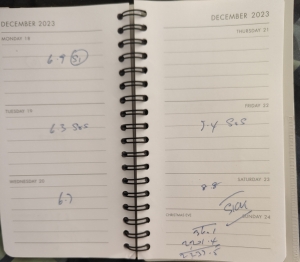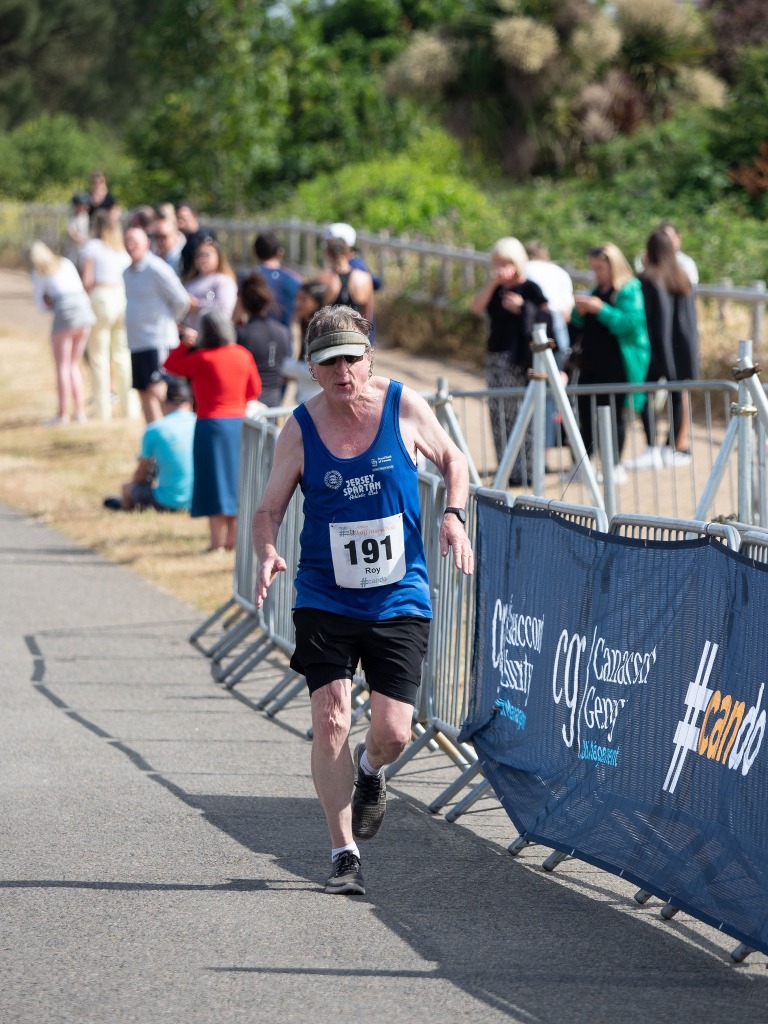Well my running year ended in a whimper as I picked up a bug on the 23rd December and was unable to run the well-attended Boxing Day 10k. I was then work-tied for the Bouley Bay Hill Climb and, this morning, a final run out with the Skivers and Slackers group was cancelled after a Red weather warning, so we went straight to the coffee for a change.
But 2023 has been fun. Moving into the M70 group at the end of February meant that I could challenge for prizes in a few of the races, a rare treat for an average runner. In reality there are very few of us in Jersey still competing at age 70, the best being Bob Hurst who is now well into his eighth decade and who has represented England in the M75 age group. Fortunately Bob doesn’t do many of the local races!
Health and weight
I continue to be very fortunate health wise – no injuries or illness until I picked up that bug a few days back. My vegan lifestyle has undoubtedly helped a lot in this regard, even though I might cheat a little at times. The way I train helps me avoid injuries and this is vital as the years fly by. Weight-wise I do have to be careful but I’ve managed OK in that department.
Mileage
For me this is a vital area – keep up the miles and performance will follow. I finished the year on 2,237kms (1,390 miles) compared with 2,310 in 2022 and 2,283 in 2021.
Training
I try to get out of the door 4 – 6 times a week and I have a weekly target of 50km in my head, though I don’t often hit that. Most of this training is done at an easy pace – it’s my firm view that speedwork at my age won’t produce significant gains and I run the risk of a show-stopping injury from which I might not recover. A few track sessions of long intervals maybe, but otherwise I get my speed done in a race context.
This year I have however made a big effort to include hills, which are less impactful on the lower limbs. I’ve been logging most of Jersey’s big hills and knocking them off one by one. I’ve long believed that one should welcome hills in as training friends, not avoid them. A positive attitude to our hilly friends works wonders.
The Races
17 Jan – Spartan 5k 24.26. As always, anything in the 24s is good.
28 Feb – Spartan 5k 24.05.
11 March – Spartan 8k 40.29.
21 March – Spartan 5k 24.10.
25 March – Hospice Half-Marathon 1:53.00. My first ‘podium’, 2nd M70, beaten only by Bob Hurst. Very happy with this.
1 April – Spartan Spring 10k 50.12 – happy with time though aiming for sub-50. What a lousy turnout though, 35 runners only.
11 April – Spartan 5k 24.25.
14 May – Durrell Challenge 13k 1:14, slightly slower than last year, 133rd out of 276. Always one of the highlight races of the year with some killer hills.
10 June – Jersey Half-Marathon 1:58.21. What a struggle right from the start so happy to go sub-2. 173rd out of 379 and my first M70 win.
22 June – Sunset Trophy 29.14. Distance of 5.2k irrelevant really for this lung-buster up the sand dunes. Attaining the level high ground alive seems a win in itself with the flat/downhill finish to follow.
24 June – Headway 10k 51.27 on a very warm morning. First M70.
4 July – Spartan 5k 23.57, my fastest of the year.
20 July – Spartan 8k 41.11.
19 August – Jayson Lee 10k 50.37. Over a minute slower than last year but still good to be competing in what seems to be the penultimate running of this great community event. 87th out of 251.
3 September – Spartan Half-Marathon 1:58.33, 145th out of 231. A right battle in the second half as the temperature soared. Just run out of the M70 prize by Bernie Arthur.
12 September – Spartan 5k 24.25.
15 Sept – Night of the 5000 PBs, a series of graded 5,000 metre races held on the track, 24.02. A new event and the first venture onto the track for many. I ran in the first and slowest of the heats, went out faster than I’d planned and had to hang on for grim death as I was chased down. Great fun though and happy with that time.
8 October – Autumn 10k 51.38 on the St Catherine course. Disappointing time really.
24 October – Spartan 5k 24.32.
18 November – Running for Frubbs Headway 10-miler, 1:28 and first M70. A really tough battle in a near-gale but happy to pick up my prize.
3 December – Durrell Dash (11.4k) 62.30, 83rd out of 167, a few seconds quicker than last year.
So, what next? Nothing for it but to re-set the clock to zero and head into 2024. I’m still thoroughly enjoying my running and I believe this all adds to general wellbeing of both body and mind. I love the training, but particularly the races – there is a lovely running community in Jersey. And there’s no doubt that the running scene in the Island is healthy in numbers. It’s well-acknowledged that the standard at the higher end has fallen a long way from where it was 30-40 years ago, but the numbers participating are healthy and growing. And I’m happy to still be a part of it.










